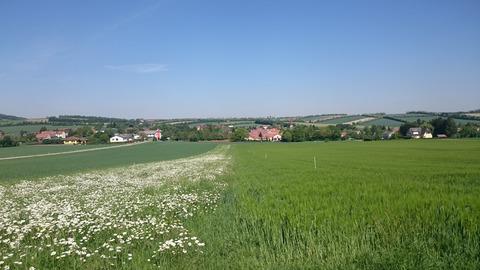当前位置:
X-MOL 学术
›
J. Appl. Ecol.
›
论文详情
Our official English website, www.x-mol.net, welcomes your
feedback! (Note: you will need to create a separate account there.)
Functional traits driving pollinator and predator responses to newly established grassland strips in agricultural landscapes
Journal of Applied Ecology ( IF 5.0 ) Pub Date : 2021-05-23 , DOI: 10.1111/1365-2664.13892 Bea Maas 1, 2 , Manuela Brandl 2 , Raja Imran Hussain 2 , Thomas Frank 2 , Klaus Peter Zulka 3, 4 , Dominik Rabl 1, 2, 5 , Ronnie Walcher 2 , Dietmar Moser 1
中文翻译:

驱动授粉者和捕食者对农业景观中新建立的草原带的反应的功能特征
更新日期:2021-05-23
Journal of Applied Ecology ( IF 5.0 ) Pub Date : 2021-05-23 , DOI: 10.1111/1365-2664.13892 Bea Maas 1, 2 , Manuela Brandl 2 , Raja Imran Hussain 2 , Thomas Frank 2 , Klaus Peter Zulka 3, 4 , Dominik Rabl 1, 2, 5 , Ronnie Walcher 2 , Dietmar Moser 1
Affiliation

|
- Agricultural biodiversity and associated ecosystem functions are declining at alarming rates due to widespread land use intensification. They can only be maintained through targeted landscape management that supports species with different habitat preferences, dispersal capacities and other functional traits that determine their survival. However, we need better understanding whether short-term measures can already improve functional diversity in European agroecosystems.
- We investigated spatio-temporal responses of bees (solitary bees, bumblebees and honey bees), hoverflies, carabid beetles and spiders to newly established grassland strips in Lower Austria over 3 years, and along a distance gradient to old grasslands. Specifically, we asked if new grasslands, compared to old grasslands and cereal fields, serve as temporal dispersal habitat or corridor, and how species-specific traits affect dispersal patterns. Using a trait-based functional diversity approach, we investigated year and distance effects for nine selected key traits per taxon (e.g. body size, feeding guild and habitat preferences).
- Our results show that the functional diversity of predators and pollinators (i.e. functional richness and evenness), as well as community-weighted means of selected key traits in new grasslands significantly differed from adjacent cereal fields, but only slowly adjusted to adjacent old grasslands. These effects significantly decreased with increasing distance to old grasslands for carabids and spiders, but not for mobile bees and hoverflies.
- Synthesis and applications. Over 3 years, newly established grassland strips supported larger sized and actively foraging/hunting species in the agricultural landscape. Adjacent crops likely benefit from such measures through enhanced functional diversity and related ecosystem services. However, our results also suggest that 3-year period is too short to enhance the occurrence of pollinators and epigeic predators in new grasslands. Agri-environment measures need to be complemented by the conservation of permanent habitats to effectively maintain species and functional diversity. Our findings should be acknowledged by European policy and agricultural decision makers for the design of more effective agri-environment schemes, taking into account trait-dependent species responses to land use change.
中文翻译:

驱动授粉者和捕食者对农业景观中新建立的草原带的反应的功能特征
- 由于广泛的土地利用集约化,农业生物多样性和相关的生态系统功能正在以惊人的速度下降。它们只能通过有针对性的景观管理来维护,这些管理支持具有不同栖息地偏好、传播能力和其他决定其生存的功能特征的物种。然而,我们需要更好地了解短期措施是否已经可以改善欧洲农业生态系统的功能多样性。
- 我们调查了蜜蜂(独蜂、大黄蜂和蜜蜂)、食蚜蝇、甲虫和蜘蛛在 3 年内对下奥地利新建立的草原带的时空响应,以及沿距离梯度到旧草原的时空响应。具体而言,我们询问了与旧草原和谷地相比,新草原是否作为时间扩散栖息地或走廊,以及物种特异性特征如何影响扩散模式。使用基于性状的功能多样性方法,我们调查了每个分类群九个选定关键性状的年份和距离效应(例如体型、觅食行会和栖息地偏好)。
- 我们的研究结果表明,新草原中捕食者和传粉者的功能多样性(即功能丰富度和均匀度)以及选定关键性状的群落加权平均值与相邻的谷田显着不同,但只是缓慢地适应相邻的旧草原。这些影响随着与旧草原的距离增加而显着降低,但对于移动的蜜蜂和食蚜蝇而言则不然。
- 合成与应用。3 年多来,新建立的草原带在农业景观中支持了更大尺寸和积极觅食/狩猎的物种。通过增强功能多样性和相关的生态系统服务,相邻作物可能会从这些措施中受益。然而,我们的研究结果还表明,3 年的时间太短,无法增加新草原中传粉媒介和表观天敌的出现。农业环境措施需要辅以永久栖息地的保护,以有效维持物种和功能的多样性。我们的发现应该得到欧洲政策和农业决策者的认可,以设计更有效的农业环境计划,同时考虑到依赖特性的物种对土地利用变化的反应。











































 京公网安备 11010802027423号
京公网安备 11010802027423号